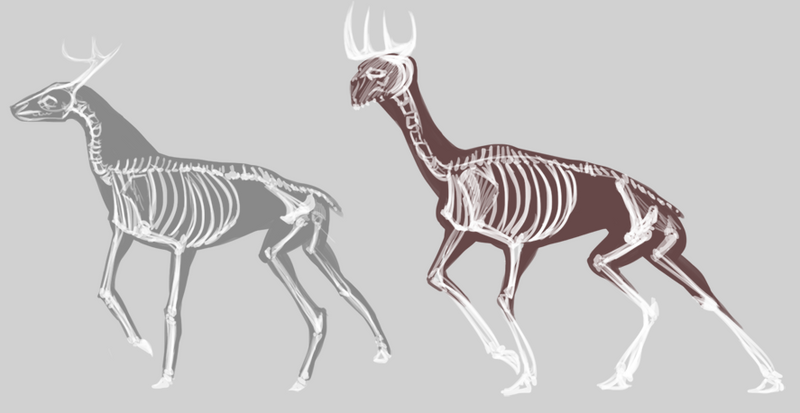Foreword:
This blog is not a How-To of character creation; it is a collection of tips, questions, and exercises to help you in the development of a believable and visually engaging design. This blog focuses primarily on visual design, how your character looks, as opposed to things like personality or behavior.
Anatomy: Designing from the Inside Out
Ask yourself if your character could actually exist. Does your character have bones and muscles where necessary, or are limbs just tacked on? The best and most believable designs look like they could crawl right off the page, they break the rules of reality while still looking like they could be real.
Skeletal structure:
-Are there bones where bones are necessary?
-How large is your character, does the skeleton represent this?
-Does your character have normal or exaggerated proportions?
Muscle structure:
-What build is your character? Are they slim, heavy, muscled or flabby?
-Are there muscles where necessary?
-Are these muscles more developed in some areas than others? Why?
Posture:
-How does your character stand. Why?
-Does this posture effect how your character moves?
Amputation or Incomplete Anatomy:
-Is there an important reason your character is missing bits?
-How does this loss effect the above three points?
-How does this loss effect how your character moves?
A great way to test if your character has a visually interesting anatomy is the Silhouette Test. Draw the general shape of your character in a solid block. You want a design that is identifiable simply by looking at the basic outline. This test prevents the common flaw of expressing character only through ‘pasted on’ traits like markings and scars, or through accessories like jewellery or clothing.
Example of the Silhouette Test with Additional Skeletal Details
 The deer on the left is an average Real World deer, the character on the right is Teradeer.
The deer on the left is an average Real World deer, the character on the right is Teradeer.
Note both the exaggerated proportions and posture are still possible within the restraints of realistic anatomy.
Accessories: Dressing a Character
Anything nonessential to the physical structure of your character is considered an accessory. Hair, fur, markings, scars, tattoos, piercings, weapons, armor, jewellery, clothing, all of these are important to character design. As with all things, a balance must be maintained; be careful of adding too many superfluous things, or including things not critical to your character in its design.
-Is there a reason my character is decorated the way it is?
-Does this decoration express or contradict the personality of that character?
-Can the character physically wear/manipulate the decoration? If not, how did it get there?
-Do accessories stay on realistically, or by magic? If magically, why?
Parting Words:
Character development is a continual cycle. It doesn't matter if you've had the character three minutes or three years, they can always be pushed farther. If you put effort into making your character, others will appreciate it far more than something you pasted together from buzz-words and passing fancies. I am not telling you how you can and can not make your character. It is simply my wish to inform and hopefully inspire deep and well developed characters. If you want your character to be taken seriously, and to generate genuine interest, put thought and time into it. You won't be sorry.
[As with all my blogs, if you spot an grammar or coding error, please point it out so I can fix it! :)]

Well done! I hope people will
Nice, thank you for this.
Going to bookmark so I can come and read through it when need be again.
♥! Thanks Tera
Thanks Tera
Inspired me to make this.
Absolutely love it! Thank you
Thank you so much for writing this! <3
Excellent (: I've been
I've been meaning to write an extended piece describing Dag. Would you mind me using these as prompts?
Saosin: Very cool, I love
Shamiya: I'm glad you find it helpful.
Kitty: You're more than welcome.
Amazon: I'm glad you enjoyed reading it.
Dag: I don't mind at all, I look forward to reading it should you choose to post!
trackin!
This looks very helpful!
Very insightful and useful!
This is really awesome. n__n
AH! This is fantastic! I love
.
Oooh, this is really handy.
Passing fancies lol Real bad
<3
.
Hey, this is super
Imma bump it.
Thanks so much! Can I ask, is
Hi there Muc, glad you like
In terms of which style is best, that really depends on two things; the style you prefer and the style that best suits the character. In my experiences, character designs with exaggerated anatomy tend to look scary when portrayed realistically. For example, a design that has big eyes can look cute in a cartoon style, but rather unnerving realistically. Take a look at the character you want to draw and make a list of the important traits they have and then play around with various styles.
Experiment, try drawing the character in several styles, or even blend them until you find something you enjoy and that looks good for the character.